Unit 4 Space Exploration Reading and Thinking 课件(共54张PPT) 高中英语新人教版(2019)必修第三册(2022学年)
文档属性
| 名称 | Unit 4 Space Exploration Reading and Thinking 课件(共54张PPT) 高中英语新人教版(2019)必修第三册(2022学年) |  | |
| 格式 | pptx | ||
| 文件大小 | 6.5MB | ||
| 资源类型 | 教案 | ||
| 版本资源 | 人教版(2019) | ||
| 科目 | 英语 | ||
| 更新时间 | 2025-03-02 13:33:50 | ||
图片预览






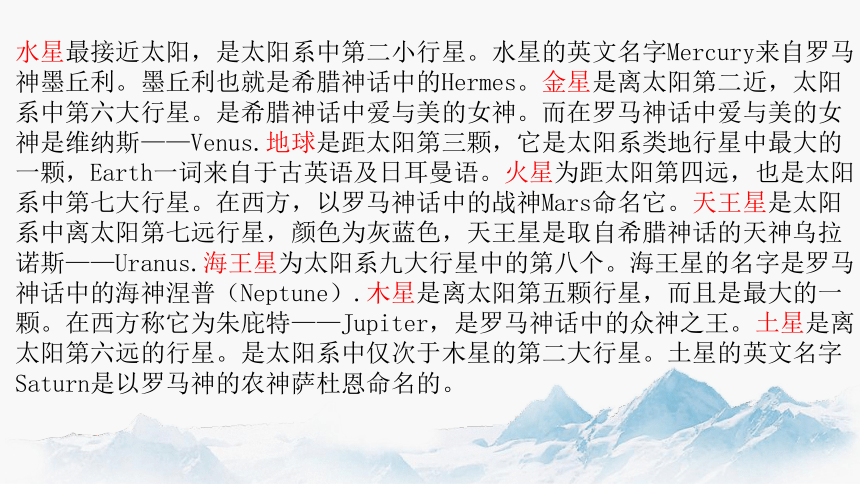

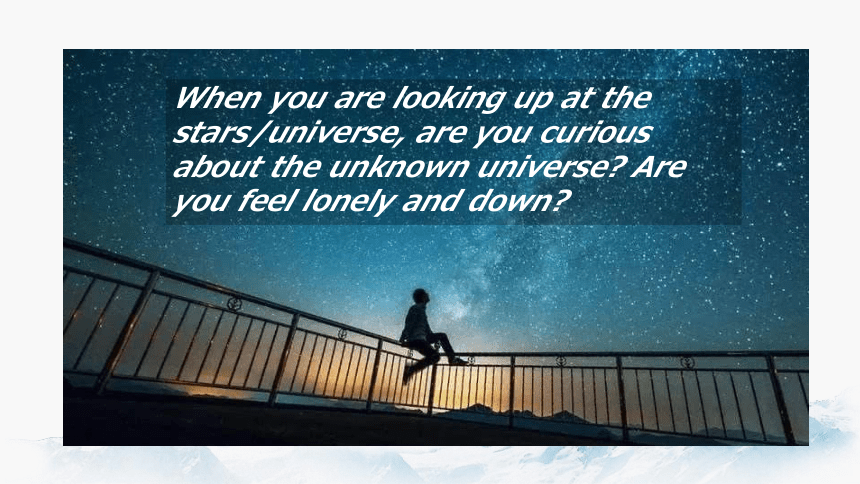
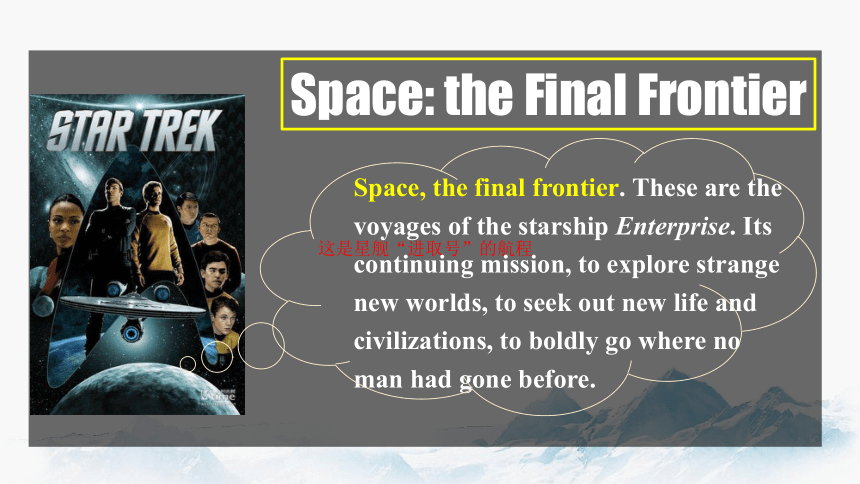
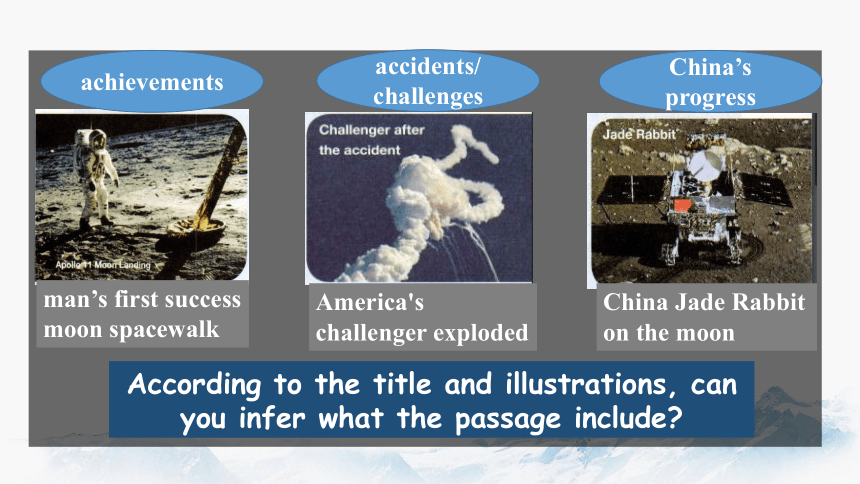
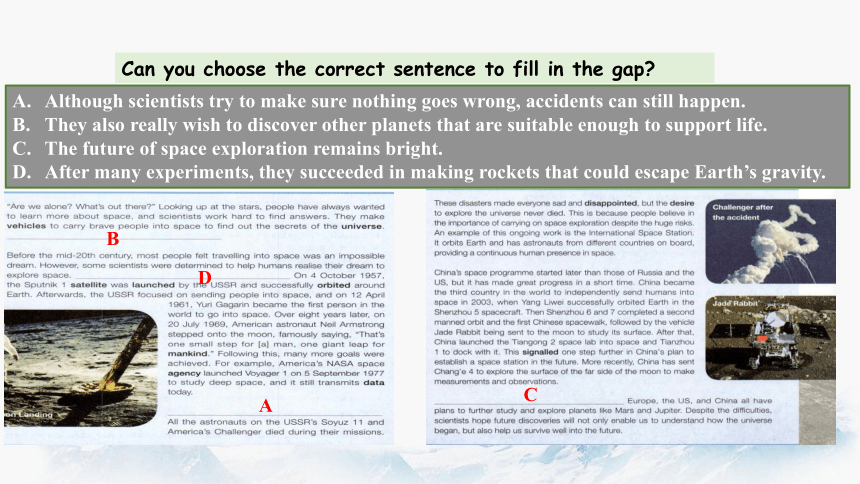
文档简介
(共54张PPT)
Unit 4 Space Exploration
Reading and Thinking
Mystery created wonder and wonder is the basis of man’s desire to understand.神秘感激发好奇心,而好奇心则是人们探索未知事物的前提
——Neil Armstrong
2019年4月10日人类首次直接拍摄到的黑洞照片
黑洞(Black hole)
1.How old is the earth
Of the earth surface is covered by water.
How many planets are there in the solar system
How long does the rotation of the earth take
What are the planets in our solar system
About 4.5billion
70%
8 planets
24 hours
Solar system
Solar
system
水星最接近太阳,是太阳系中第二小行星。水星的英文名字Mercury来自罗马神墨丘利。墨丘利也就是希腊神话中的Hermes。金星是离太阳第二近,太阳系中第六大行星。是希腊神话中爱与美的女神。而在罗马神话中爱与美的女神是维纳斯——Venus.地球是距太阳第三颗,它是太阳系类地行星中最大的一颗,Earth一词来自于古英语及日耳曼语。火星为距太阳第四远,也是太阳系中第七大行星。在西方,以罗马神话中的战神Mars命名它。天王星是太阳系中离太阳第七远行星,颜色为灰蓝色,天王星是取自希腊神话的天神乌拉诺斯——Uranus.海王星为太阳系九大行星中的第八个。海王星的名字是罗马神话中的海神涅普(Neptune).木星是离太阳第五颗行星,而且是最大的一颗。在西方称它为朱庇特——Jupiter,是罗马神话中的众神之王。土星是离太阳第六远的行星。是太阳系中仅次于木星的第二大行星。土星的英文名字Saturn是以罗马神的农神萨杜恩命名的。
Yuri Gagarin,
the Soviet Union
the first man to travel into space in 1961
the first person to walk on the moon in 1969
Neil Armstrong,
the US
astronaut
pioneer
When you are looking up at the stars/universe, are you curious about the unknown universe Are you feel lonely and down
这是星舰“进取号”的航程
Space: the Final Frontier
Space, the final frontier. These are the voyages of the starship Enterprise. Its continuing mission, to explore strange new worlds, to seek out new life and civilizations, to boldly go where no man had gone before.
man’s first success moon spacewalk
America's challenger exploded
China Jade Rabbit on the moon
According to the title and illustrations, can you infer what the passage include
achievements
accidents/
challenges
China’s progress
Although scientists try to make sure nothing goes wrong, accidents can still happen.
They also really wish to discover other planets that are suitable enough to support life.
The future of space exploration remains bright.
After many experiments, they succeeded in making rockets that could escape Earth’s gravity.
Can you choose the correct sentence to fill in the gap
C
D
B
A
Step Ⅰ Fast reading
Read for the main idea.
1.What's the main idea of the text
A.To introduce the development of human's space exploration.
B.To describe how difficult and dangerous space exploration is.
C.To encourage people to respect scientists.
D.To compare the space programmes between the US and China.
2.Match each paragraph with the main idea.
Para.1 A.The risks of space exploration.
Para.2 B.Man's efforts to realise the dream.
Para.3 C.Man's wish to explore the universe.
Para.4 D.The bright future of space exploration.
Para.5 E.China's progress in space exploration.
Step Ⅱ Careful reading
Choose the best answer according to the text.
1.What do we know about Neil Armstrong
A.He was from the USSR.
B.He was the first person to travel in space.
C.He was in charge of launching the satellites.
D.He was the first person to walk on the moon.
2.Why do people still want to explore the universe despite the disasters
A.Because they want to show how advanced science is.
B.Because they realize it is important to carry on space exploration.
C.Because they provide continuous human presence in space.
D.Because astronauts can work in the International Space Station.
3.What does the fourth paragraph mainly tell us
A.China is the third country in the world to send humans into space.
B.Yang Liwei successfully orbited Earth in the Shenzhou 5 spacecraft.
C.China has made great progress in space exploration in recent years.
D.Chang'e 4 was sent to explore the surface of the far side of the moon.
“Are we alone What’s out there ” Looking up at the stars, people have always wanted to learn more about space, and scientists work hard to find answers. They make vehicles to carry brave people into space to find out the secrets of the universe. They also really wish to discover other planets that are suitable enough to support life.
Para. 1
Why do people want to explore space
discover other planets that are suitable enough to support life
find out the secrets of the universe
learn more about space
main idea:
Humans have always had _______________
about space.
a natural curiosity
Space exploration carries human’s curiosity.
探究1
“Are we alone What’s out there ” Looking up at the stars, people have always wanted to learn more about space, and scientists work hard to find answers. They make vehicles to carry brave people into space to find out the secrets of the universe. They also really wish to discover other planets that are suitable enough to support life.
Why does the passage begin with two questions
To impress readers
To attract readers’ attention and curiosity about the content
To raise readers’ reflection
Before the mid-20th century, most people felt travelling into space was an impossible dream. However, some scientists were determined to help humans realise their dream to explore space. After many experiments, they succeeded in making rockets that could escape Earth’s gravity. On 4 October 1957, the Sputnik 1 satellite was lunched by the USSR and successfully orbited around Earth. Afterwards, the USSR focused on sending people into space, and on 12 April 1961, Yuri Gagarin became the first person in the world to go into space.
Over eight years later, on 20 July 1969, American astronaut Neil Armstrong stepped onto the moon, famously saying, “That’s one small step for [a] man, one giant leap for mankind.” Following this, many more goals were achieved. For example, America’s NASA space agency launched Voyager 1 on 5 September 1977 to study deep space, and it still transmits data today.
What’s the topic sentence in Para. 2
However, some scientists were determined to help humans realise their dream to explore space.
How realised their dream
探究2
Para. 2
before the mid-20th century
4 Oct. 1957
12 Apr. 1961
20 Jul. 1969
5 Sep. 1977
an impossible dream
The Sputnik 1 satellite was launched by the USSR
Yuri Gagarin, he first person to go into space
Neil Armstrong stepped onto the moon
Voyager 1 was sent to study deep space, and transmits data today
determination
curiosity
effort
That’s one small step for a man, a giant leap for mankind.
Space exploration motivates human’s determination, persistence, curiosity, effort and ambition.
impossible dream
a reality
Persistence坚持
Ambition雄心
before the mid-20th century
4 Oct. 1957
12 Apr. 1961
20 Jul. 1969
5 Sep. 1977
The Sputnik 1 satellite was launched by the USSR
Yuri Gagarin, he first person to go into space
Neil Armstrong stepped onto the moon
Voyager 1 was sent to study deep space, and transmits data today
The USA
The USSR
VS
Why was space exploration mainly carried out by the USSR and the US in the 20th century
the Cold War
competition between two superpowers
Further thinking:
How does the writer show the achievements in space exploration
using examples C. giving specific number
making comparison D. giving definition
Writing tip 1 : Examples and specific numbers can make a scientific article more pervasive and objective.
What are benefits of using examples and specific numbers
To be more detailed, vivid and persuasive
To impress readers with great progress in space exploration
To make it more easy-understanding
before the mid-20th century
4 Oct. 1957
12 Apr. 1961
20 Jul. 1969
5 Sep. 1977
The Sputnik 1 satellite was launched by the USSR
Yuri Gagarin, he first person to go into space
Neil Armstrong stepped onto the moon
Voyager 1 was sent to study deep space, and transmits data today
However, some scientists were determined to help humans realise their dream to explore space.
main idea:
Space travel became __________ in the 20th century with ________ and ________________ remarkable mission.
the Soviet Union
American
a reality
Space exploration is always successful and satisfying
Do humans stop exploring space due to problems or failures
Why don’t humans stop
Although scientists try to make sure nothing goes wrong, accidents can still happen. All the astronauts on the USSR’s Soyuz 11 and America’s Challenger died during their missions. These disasters made everyone sad and disappointed , but the desire to explore the universe never died. This is because people believe in the importance of carrying on space exploration despite the huge risks. An example of this ongoing work is the International Space Station. It orbits Earth and has astronauts from different countries on board, providing a continuous human presence in space.
Although scientists try to make sure nothing goes wrong, accidents
can still happen
What’s the topic sentence in Para. 3
What accident is showed
Why don’t people stop exploring
Space Station
International
cooperation
Space exploration enlightens international cooperation.
What proof 如何证明
探究3
Para. 3
main idea:
Space travel has always involved _________, but despite ______ exploration _________.
great risks
risks
continues
Although scientists try to make sure nothing goes wrong, accidents can still happen. All the astronauts on the USSR’s Soyuz 11 and America’s Challenger died during their missions. These disasters made everyone sad and disappointed , but the desire to explore the universe never died. This is because people believe in the importance of carrying on space exploration despite the huge risks. An example of this ongoing work is the International Space Station. It orbits Earth and has astronauts from different countries on board, providing a continuous human presence in space.
Although scientists try to make sure nothing goes wrong, accidents
can still happen
Space Station
International
cooperation
July 23, 2020, Tianwen 1 – a Mars probe, was sent to the Space.
Zhurong, one of the mission rover漫游者 of the Tianwen 1, is tasked with detailed mission.
China also made great progress in space exploration!
China’s space programme started later than those of Russia and the US, but it has made great progress in a short time. China became the third country in the world to independently send humans into space in 2003, when Yang Liwei successfully orbited Earth in the Shenzhou 5 spacecraft. Then Shenzhou 6 and 7 completed a second manned orbit and the first Chinese spacewalk, followed by the vehicle Jade Rabbit being sent to the moon to study its surface. After that, China launched the Tiangong 2 space lab into space and Tianzhou1 to dock with it. This signalled one step further in China’s plan to establish a space station in the future. More recently, China has sent Chang’e 4 to explore the surface of the far side of the moon to make measurements and observations.
What’s the topic sentence in Para. 4
What progress did China make
China’s space programme started later than those of Russia and the US,
but it has made great progress in a short time
探究4
Para. 4
In 2003
independently send humans into space
China launched it into space and Tianzhou1 to dock with it
completed a second manned orbit and the first Chinese spacewalk
the vehicle Jade Rabbit studies the moon’s surface.
Shenzhou 6 and 7
Shenzhou 5 spacecraft
Yang Liwei
Tiangong 2 space lab
Chang’e 4
explore the surface of the far side of the moon to make measurements and observations
This signalled one step further in China’s plan to establish a space station in the future.
Space exploration witnesses China’s progress.
main idea:
China has __________________ in space exploration in the early 21st century, becoming only _________ country to send humans into space.
the third
made great progress
China’s space programme started later than those of Russia and the US, but it has made great progress in a short time. China became the third country in the world to independently send humans into space in 2003, when Yang Liwei successfully orbited Earth in the Shenzhou 5 spacecraft. Then Shenzhou 6 and 7 completed a second manned orbit and the first Chinese spacewalk, followed by the vehicle Jade Rabbit being sent to the moon to study its surface. After that, China launched the Tiangong 2 space lab into space and Tianzhou1 to dock with it. This signalled one step further in China’s plan to establish a space station in the future. More recently, China has sent Chang’e 4 to explore the surface of the far side of the moon to make measurements and observations.
China’s space programme started later than those of Russia and the US,
but it has made great progress in a short time
What’s the future of space exploration
Is it bright or hopeless
The future of space exploration remains bright. Europe, the US, and China all have plans to further study and explore planets like Mars and Jupiter. Despite the difficulties, scientists hope future discoveries will not only enable us to understand how the universe began, but also help us survive well into the future.
What’s the topic sentence in Para. 5
Why is the future bright
What does space exploration mean to us
The future of space exploration remains bright
/international
future plan
/Chinese growing contributions
/developing science and technology
universe began, but also help us survive well into the future.
will not only enable us to understand how the
Space exploration links humans and future.
/more knowledge and
/human’s determination, curiosity and effort
cooperation
experience
探究5
Para. 5
main idea:
The _______ of space exploration looks _______, as many countries are planning _____________.
bright
future
further missions
The future of space exploration remains bright. Europe, the US, and China all have plans to further study and explore planets like Mars and Jupiter. Despite the difficulties, scientists hope future discoveries will not only enable us to understand how the universe began, but also help us survive well into the future.
The future of space exploration remains bright
universe began, but also help us survive well into the future.
will not only enable us to understand how the
Further thinking:
What’s the significance of space exploration
Space exploration carries human’s curiosity.
Space exploration motivates human’s determination, persistence, curiosity, effort and ambition.
Space exploration enlightens international cooperation.
Space exploration witnesses China’s progress.
Space exploration links humans and future.
significant
necessary
rewarding
Para. 1
Para. 5
Para. 2
start the topic of space exploration
achievements
accidents/challenges
Para. 3
Para. 4
China’s progress
bright future of space exploration
structure
Step Ⅲ Post reading
After reading the passage, please fill in the following blanks.
People have always wanted to learn more about space. Before the mid-20th century, most people felt __1__ (travel) into space was an impossible dream. However, __2__ the help of scientists, people succeeded in realizing their dream __3__ (explore) space. On 4 October 1957, the Sputnik 1 satellite __4__ (launch) by the USSR. __5__ scientists try to make sure nothing goes wrong,accidents can still happen. These disasters made everyone __6__ (disappoint), but people still believe in the importance of __7__ (carry) on space exploration. In 2003, China became the third country to __8__ (independent) send humans into space. Then Shenzhou 6 and 7 completed __9__ second manned orbit and the first Chinese spacewalk. In spite of the difficulties, scientists hope future __10__ (discovery) will not only enable us to understand the universe, but also help us survive well into the future.
Unit 4 Space Exploration
Reading and Thinking
Mystery created wonder and wonder is the basis of man’s desire to understand.神秘感激发好奇心,而好奇心则是人们探索未知事物的前提
——Neil Armstrong
2019年4月10日人类首次直接拍摄到的黑洞照片
黑洞(Black hole)
1.How old is the earth
Of the earth surface is covered by water.
How many planets are there in the solar system
How long does the rotation of the earth take
What are the planets in our solar system
About 4.5billion
70%
8 planets
24 hours
Solar system
Solar
system
水星最接近太阳,是太阳系中第二小行星。水星的英文名字Mercury来自罗马神墨丘利。墨丘利也就是希腊神话中的Hermes。金星是离太阳第二近,太阳系中第六大行星。是希腊神话中爱与美的女神。而在罗马神话中爱与美的女神是维纳斯——Venus.地球是距太阳第三颗,它是太阳系类地行星中最大的一颗,Earth一词来自于古英语及日耳曼语。火星为距太阳第四远,也是太阳系中第七大行星。在西方,以罗马神话中的战神Mars命名它。天王星是太阳系中离太阳第七远行星,颜色为灰蓝色,天王星是取自希腊神话的天神乌拉诺斯——Uranus.海王星为太阳系九大行星中的第八个。海王星的名字是罗马神话中的海神涅普(Neptune).木星是离太阳第五颗行星,而且是最大的一颗。在西方称它为朱庇特——Jupiter,是罗马神话中的众神之王。土星是离太阳第六远的行星。是太阳系中仅次于木星的第二大行星。土星的英文名字Saturn是以罗马神的农神萨杜恩命名的。
Yuri Gagarin,
the Soviet Union
the first man to travel into space in 1961
the first person to walk on the moon in 1969
Neil Armstrong,
the US
astronaut
pioneer
When you are looking up at the stars/universe, are you curious about the unknown universe Are you feel lonely and down
这是星舰“进取号”的航程
Space: the Final Frontier
Space, the final frontier. These are the voyages of the starship Enterprise. Its continuing mission, to explore strange new worlds, to seek out new life and civilizations, to boldly go where no man had gone before.
man’s first success moon spacewalk
America's challenger exploded
China Jade Rabbit on the moon
According to the title and illustrations, can you infer what the passage include
achievements
accidents/
challenges
China’s progress
Although scientists try to make sure nothing goes wrong, accidents can still happen.
They also really wish to discover other planets that are suitable enough to support life.
The future of space exploration remains bright.
After many experiments, they succeeded in making rockets that could escape Earth’s gravity.
Can you choose the correct sentence to fill in the gap
C
D
B
A
Step Ⅰ Fast reading
Read for the main idea.
1.What's the main idea of the text
A.To introduce the development of human's space exploration.
B.To describe how difficult and dangerous space exploration is.
C.To encourage people to respect scientists.
D.To compare the space programmes between the US and China.
2.Match each paragraph with the main idea.
Para.1 A.The risks of space exploration.
Para.2 B.Man's efforts to realise the dream.
Para.3 C.Man's wish to explore the universe.
Para.4 D.The bright future of space exploration.
Para.5 E.China's progress in space exploration.
Step Ⅱ Careful reading
Choose the best answer according to the text.
1.What do we know about Neil Armstrong
A.He was from the USSR.
B.He was the first person to travel in space.
C.He was in charge of launching the satellites.
D.He was the first person to walk on the moon.
2.Why do people still want to explore the universe despite the disasters
A.Because they want to show how advanced science is.
B.Because they realize it is important to carry on space exploration.
C.Because they provide continuous human presence in space.
D.Because astronauts can work in the International Space Station.
3.What does the fourth paragraph mainly tell us
A.China is the third country in the world to send humans into space.
B.Yang Liwei successfully orbited Earth in the Shenzhou 5 spacecraft.
C.China has made great progress in space exploration in recent years.
D.Chang'e 4 was sent to explore the surface of the far side of the moon.
“Are we alone What’s out there ” Looking up at the stars, people have always wanted to learn more about space, and scientists work hard to find answers. They make vehicles to carry brave people into space to find out the secrets of the universe. They also really wish to discover other planets that are suitable enough to support life.
Para. 1
Why do people want to explore space
discover other planets that are suitable enough to support life
find out the secrets of the universe
learn more about space
main idea:
Humans have always had _______________
about space.
a natural curiosity
Space exploration carries human’s curiosity.
探究1
“Are we alone What’s out there ” Looking up at the stars, people have always wanted to learn more about space, and scientists work hard to find answers. They make vehicles to carry brave people into space to find out the secrets of the universe. They also really wish to discover other planets that are suitable enough to support life.
Why does the passage begin with two questions
To impress readers
To attract readers’ attention and curiosity about the content
To raise readers’ reflection
Before the mid-20th century, most people felt travelling into space was an impossible dream. However, some scientists were determined to help humans realise their dream to explore space. After many experiments, they succeeded in making rockets that could escape Earth’s gravity. On 4 October 1957, the Sputnik 1 satellite was lunched by the USSR and successfully orbited around Earth. Afterwards, the USSR focused on sending people into space, and on 12 April 1961, Yuri Gagarin became the first person in the world to go into space.
Over eight years later, on 20 July 1969, American astronaut Neil Armstrong stepped onto the moon, famously saying, “That’s one small step for [a] man, one giant leap for mankind.” Following this, many more goals were achieved. For example, America’s NASA space agency launched Voyager 1 on 5 September 1977 to study deep space, and it still transmits data today.
What’s the topic sentence in Para. 2
However, some scientists were determined to help humans realise their dream to explore space.
How realised their dream
探究2
Para. 2
before the mid-20th century
4 Oct. 1957
12 Apr. 1961
20 Jul. 1969
5 Sep. 1977
an impossible dream
The Sputnik 1 satellite was launched by the USSR
Yuri Gagarin, he first person to go into space
Neil Armstrong stepped onto the moon
Voyager 1 was sent to study deep space, and transmits data today
determination
curiosity
effort
That’s one small step for a man, a giant leap for mankind.
Space exploration motivates human’s determination, persistence, curiosity, effort and ambition.
impossible dream
a reality
Persistence坚持
Ambition雄心
before the mid-20th century
4 Oct. 1957
12 Apr. 1961
20 Jul. 1969
5 Sep. 1977
The Sputnik 1 satellite was launched by the USSR
Yuri Gagarin, he first person to go into space
Neil Armstrong stepped onto the moon
Voyager 1 was sent to study deep space, and transmits data today
The USA
The USSR
VS
Why was space exploration mainly carried out by the USSR and the US in the 20th century
the Cold War
competition between two superpowers
Further thinking:
How does the writer show the achievements in space exploration
using examples C. giving specific number
making comparison D. giving definition
Writing tip 1 : Examples and specific numbers can make a scientific article more pervasive and objective.
What are benefits of using examples and specific numbers
To be more detailed, vivid and persuasive
To impress readers with great progress in space exploration
To make it more easy-understanding
before the mid-20th century
4 Oct. 1957
12 Apr. 1961
20 Jul. 1969
5 Sep. 1977
The Sputnik 1 satellite was launched by the USSR
Yuri Gagarin, he first person to go into space
Neil Armstrong stepped onto the moon
Voyager 1 was sent to study deep space, and transmits data today
However, some scientists were determined to help humans realise their dream to explore space.
main idea:
Space travel became __________ in the 20th century with ________ and ________________ remarkable mission.
the Soviet Union
American
a reality
Space exploration is always successful and satisfying
Do humans stop exploring space due to problems or failures
Why don’t humans stop
Although scientists try to make sure nothing goes wrong, accidents can still happen. All the astronauts on the USSR’s Soyuz 11 and America’s Challenger died during their missions. These disasters made everyone sad and disappointed , but the desire to explore the universe never died. This is because people believe in the importance of carrying on space exploration despite the huge risks. An example of this ongoing work is the International Space Station. It orbits Earth and has astronauts from different countries on board, providing a continuous human presence in space.
Although scientists try to make sure nothing goes wrong, accidents
can still happen
What’s the topic sentence in Para. 3
What accident is showed
Why don’t people stop exploring
Space Station
International
cooperation
Space exploration enlightens international cooperation.
What proof 如何证明
探究3
Para. 3
main idea:
Space travel has always involved _________, but despite ______ exploration _________.
great risks
risks
continues
Although scientists try to make sure nothing goes wrong, accidents can still happen. All the astronauts on the USSR’s Soyuz 11 and America’s Challenger died during their missions. These disasters made everyone sad and disappointed , but the desire to explore the universe never died. This is because people believe in the importance of carrying on space exploration despite the huge risks. An example of this ongoing work is the International Space Station. It orbits Earth and has astronauts from different countries on board, providing a continuous human presence in space.
Although scientists try to make sure nothing goes wrong, accidents
can still happen
Space Station
International
cooperation
July 23, 2020, Tianwen 1 – a Mars probe, was sent to the Space.
Zhurong, one of the mission rover漫游者 of the Tianwen 1, is tasked with detailed mission.
China also made great progress in space exploration!
China’s space programme started later than those of Russia and the US, but it has made great progress in a short time. China became the third country in the world to independently send humans into space in 2003, when Yang Liwei successfully orbited Earth in the Shenzhou 5 spacecraft. Then Shenzhou 6 and 7 completed a second manned orbit and the first Chinese spacewalk, followed by the vehicle Jade Rabbit being sent to the moon to study its surface. After that, China launched the Tiangong 2 space lab into space and Tianzhou1 to dock with it. This signalled one step further in China’s plan to establish a space station in the future. More recently, China has sent Chang’e 4 to explore the surface of the far side of the moon to make measurements and observations.
What’s the topic sentence in Para. 4
What progress did China make
China’s space programme started later than those of Russia and the US,
but it has made great progress in a short time
探究4
Para. 4
In 2003
independently send humans into space
China launched it into space and Tianzhou1 to dock with it
completed a second manned orbit and the first Chinese spacewalk
the vehicle Jade Rabbit studies the moon’s surface.
Shenzhou 6 and 7
Shenzhou 5 spacecraft
Yang Liwei
Tiangong 2 space lab
Chang’e 4
explore the surface of the far side of the moon to make measurements and observations
This signalled one step further in China’s plan to establish a space station in the future.
Space exploration witnesses China’s progress.
main idea:
China has __________________ in space exploration in the early 21st century, becoming only _________ country to send humans into space.
the third
made great progress
China’s space programme started later than those of Russia and the US, but it has made great progress in a short time. China became the third country in the world to independently send humans into space in 2003, when Yang Liwei successfully orbited Earth in the Shenzhou 5 spacecraft. Then Shenzhou 6 and 7 completed a second manned orbit and the first Chinese spacewalk, followed by the vehicle Jade Rabbit being sent to the moon to study its surface. After that, China launched the Tiangong 2 space lab into space and Tianzhou1 to dock with it. This signalled one step further in China’s plan to establish a space station in the future. More recently, China has sent Chang’e 4 to explore the surface of the far side of the moon to make measurements and observations.
China’s space programme started later than those of Russia and the US,
but it has made great progress in a short time
What’s the future of space exploration
Is it bright or hopeless
The future of space exploration remains bright. Europe, the US, and China all have plans to further study and explore planets like Mars and Jupiter. Despite the difficulties, scientists hope future discoveries will not only enable us to understand how the universe began, but also help us survive well into the future.
What’s the topic sentence in Para. 5
Why is the future bright
What does space exploration mean to us
The future of space exploration remains bright
/international
future plan
/Chinese growing contributions
/developing science and technology
universe began, but also help us survive well into the future.
will not only enable us to understand how the
Space exploration links humans and future.
/more knowledge and
/human’s determination, curiosity and effort
cooperation
experience
探究5
Para. 5
main idea:
The _______ of space exploration looks _______, as many countries are planning _____________.
bright
future
further missions
The future of space exploration remains bright. Europe, the US, and China all have plans to further study and explore planets like Mars and Jupiter. Despite the difficulties, scientists hope future discoveries will not only enable us to understand how the universe began, but also help us survive well into the future.
The future of space exploration remains bright
universe began, but also help us survive well into the future.
will not only enable us to understand how the
Further thinking:
What’s the significance of space exploration
Space exploration carries human’s curiosity.
Space exploration motivates human’s determination, persistence, curiosity, effort and ambition.
Space exploration enlightens international cooperation.
Space exploration witnesses China’s progress.
Space exploration links humans and future.
significant
necessary
rewarding
Para. 1
Para. 5
Para. 2
start the topic of space exploration
achievements
accidents/challenges
Para. 3
Para. 4
China’s progress
bright future of space exploration
structure
Step Ⅲ Post reading
After reading the passage, please fill in the following blanks.
People have always wanted to learn more about space. Before the mid-20th century, most people felt __1__ (travel) into space was an impossible dream. However, __2__ the help of scientists, people succeeded in realizing their dream __3__ (explore) space. On 4 October 1957, the Sputnik 1 satellite __4__ (launch) by the USSR. __5__ scientists try to make sure nothing goes wrong,accidents can still happen. These disasters made everyone __6__ (disappoint), but people still believe in the importance of __7__ (carry) on space exploration. In 2003, China became the third country to __8__ (independent) send humans into space. Then Shenzhou 6 and 7 completed __9__ second manned orbit and the first Chinese spacewalk. In spite of the difficulties, scientists hope future __10__ (discovery) will not only enable us to understand the universe, but also help us survive well into the future.
